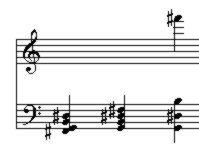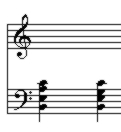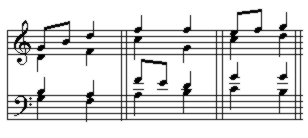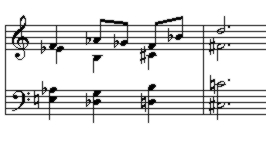General Principles of Harmony – Basics
A DEFINITION OF HARMONY
An exploration of harmony, which is not limited to one style, should encompass the following elements:
- Salient characteristics of chords.
- How chords are connected.
- Formal implications of harmonic contrasts.
- Gradations of harmonic contrast.
- A realistic look at long range tonal relationships, both in and outside of “tonal” music.
INTERVALS
Chords are traditionally considered to be the basic units of harmony. Chords are made up of intervals.
First, each interval has a distinct acoustic character. These differences are an important basis for harmonic character. For example, a chord built in 5ths will always sound more open and clear than a cluster of minor 2nds. In any style, the traditional classification of intervals into sharp dissonances, mild dissonances, rich consonances, and open consonances remains valid, simply because it is easily audible.
Second, assuming unity of timbre (i.e. one plane of tone, when several intervals are combined into a chord, multiple intervallic relationships are formed, some of which are more important than others. Here are some guidelines for how the ear prioritizes interval perception:
- The farther apart the notes of a given interval are in a chord, and the more notes are placed between them, the less the character of that interval imposes itself.

Note how the “crunch” between the G and the F# becomes progressively less important as the two notes get farther apart.
- If an interval is present more than once, placing instances of it adjacent to one another in the chord will emphasize the character of that interval.

Although both chords contain two perfect 4ths and a minor 3rd, the quartal character is more obvious in the first example.
- The more different intervals there are, especially in adjacent positions, the more complex the intervallic character of the chord, since the various intervals compete for the listener’s attention. (Too much intervallic variety is the cause of the harmonic grayness common in badly written serial music.)
- Finally, as Persichetti points out, multiple minor seconds within one chord have a “clotting” effect: They tend to obscure the sense of direction, since there are multiple harsh dissonances competing for the listener’s attention.
CHORDS
Harmony is traditionally defined as the study of chords, where a chord is a group of notes perceived as a unit, either due to simultaneous attack, or arpeggiation. This definition needs some elaboration if it is to be generalized.
In unfamiliar styles, the only way the listener can distinguish chord tones from non-harmonic tones is if straightforward harmonic norms are established very clearly, early on in the piece, thus limiting the harmonic world. All other things being equal, the more complex the harmonic world, the harder it is to sense non-chord tones. While there is no absolute reason for using non-harmonic tones, they: allow for more subtle gradation and variety of harmonic effect, lighten the texture, and allow the composer to follow his melodic impulses more easily.

In classical homophonic textures such as this one, there are three possible situations involving notes not attacked simultaneously: arpeggiation, non-harmonic tones which suggest sub-metrical harmonies (most often 7th chords), and non-harmonic tones which are extraneous to any chord in the classical vocabulary. The above example illustrates each of these three cases. What is notable here is the varying degrees of “distance” from the underlying chord vocabulary made possible by these three options.

In this example, we see something analogous: The clear quartal character of the whole renders the Gb definitely a non-harmonic tone, while the Bb sounds like an arpeggiation, creating less tension.

In this final example, the same two notes, in the same melodic line, are roughly equal in tension, since there is no obvious harmonic norm. There is no distinction here between tones which define chords and those which do not. This makes for a certain heaviness in the harmony.
Finally, another problem in defining what constitutes a chord occurs in stratified harmony, where various degrees of orchestral blend influence perceptual fusion. We will return to this point later.
PROGRESSIONS
Progression implies a series of harmonic changes, in the same plane of tone, and presupposes a clear sense of which notes form chords (see above). In the simplest sense of the word, progression – chord change – is very important, because two critical aspects of musical movement depend on it:
- Harmonic rhythm.
- Gradation of harmonic contrast.
Psychologically, progression is a function of:
- The perception of successive, distinct chords.
- The amount of new information arriving with each chord. This of course depends on how successive events are related, which can get quite complex once other dimensions, (rhythm, register, timbre, etc.) are factored in.
Outside of familiar triadic contexts, progression is thus not always easy to define. Nonetheless, we can point to two aspects of classical progressions which we can generalize: gradation and direction.
1. By gradation, we mean the degree of perceived change. If we compare the following two examples, it is clear that the first communicates a more vigorous sense of harmonic movement than the second.

There are more successive harmonic contrasts in the first example than in the second. In both examples, the rhythmic grouping suggests three chords. In the first, none of the adjacent chords contains a common tone in the same octave. Further, as indicated by the lines connecting non-adjacent notes, there is stepwise voice leading between the chords. The lack of common tones in the same register, and the multiple conjunct inner lines create a vigorous sense of harmonic action. By contrast, in the second example, the multiple common tones make the changes (again indicated by the lines) less prominent. The point here is the clear difference between the two examples. Such gradation of harmonic effect is very important in avoiding harmonic monotony.
2. As for direction, this requires enough harmonic events for the listener to develop expectations about subsequent events. For example, a rising bass line suggests continuation in the same direction. Of course, the composer may not necessarily fulfill the expectation evoked, but it does become part of the music’s perceived structure. Here is a discussion of a more complex situation.

The first chord here appears in stages: first in the strings, followed by the bassoons and the clarinets. Each timbre adds new notes, until all are sustained together. The horn then adds a melodic fragment, which finishes on the same note as the top of the bassoon chord, thus creating a partial sense of resolution. However, the overall sense here is not so much one of progression but rather of gradually filling out a harmonic mass. After the rest, there is a clearer sense of progression, both because each chord introduces completely different notes from the preceding one, and also because the chromatic bass has a simple, rising direction. Once again, the important thing here is the use of various degrees of harmonic change to vary the sense of musical movement.
